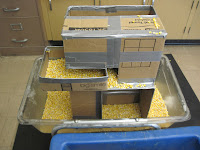Last week's post introduced the apparatus Big Box on Top.
In that post, I noted that the space inside the box was so inviting that children actually crawled into the box and sat in the table.
I kept this apparatus up for a second week with one modification: I added a cardboard tube that transversed the box horizontally.
The reason I added the horizontal tube was to prevent children from climbing into the box and into the table. Did it work?
Are you kidding me? How many tubes will it take to stop them from crawling in? I really do not have a problem with the children crawling in. Still, I wanted to see if I could stop them from climbing into the box. As you see, my experiment did not work. Silly me!
Putting aside the crawling in and out, the apparatus spawned a multitude of operations as the children played and explored the apparatus. One of the simplest operations---it is actually a set of operations---is to fill a container and then pour it down the tube. Watch how that works with these two-year-olds.
Pouring corn down the tube becomes a social operation when someone is on the other end. Watch.
Sometimes that social play involves a fair amount of negotiation, coordination, and give-and-take. You can see that in the pictures below.
The boy in the box is pouring corn through the tube to the boy with the pan outside the box. The boy in the box is actually watching the boy catch the corn in his pan through a hole in the box. (On this day, a tube was dislodged and hole big enough to see through was left in the side of the box.)
There is more negotiation here than meets the eye because before long the roles are reversed.
The boy who was inside is now outside catching the corn while the boy who was outside is now inside pouring the corn. How did that happen? Through some serious coordination and give-and-take.
There are so many of these operations that arise from play with this apparatus. Too many, in fact, to continue documenting in this post. There is one more, though, that seemed to come out of nowhere. Watch.
Some questions arise for which there are no answers. They are simply fodder for reflecting on the wonderment of children and their operations.
P.S. School is out for the summer so I will be taking a break from the blog for July and August. I will use the time to fine-tune a presentation on sensory tables for the annual conference of the National Association for the Education of Young Children in Atlanta this November.
As I plan for that presentation, I would like to ask for your help. Do you have questions about any apparatus or the process of building apparatus that have come up in the course of reading this blog? If you were to go to my presentation on sensory tables, what would you want to see or hear? Also, if you have tried to make an apparatus from the blog, which did you try and how did that work for you? The best way to learn is to do, but are there some tips that would have helped you in the doing? Also, if you thought you were going to build something you saw in the blog but did not, what gave you pause.
Please feel free to comment on the blog or contact me directly through email: tpbedard@msn.com
Thanks in advance.







































